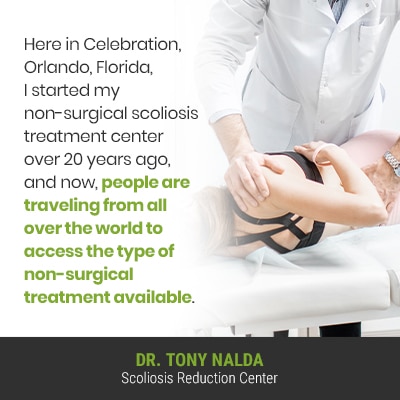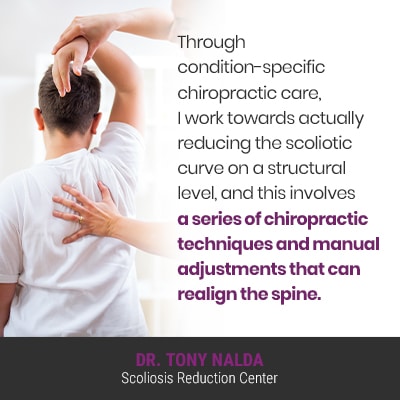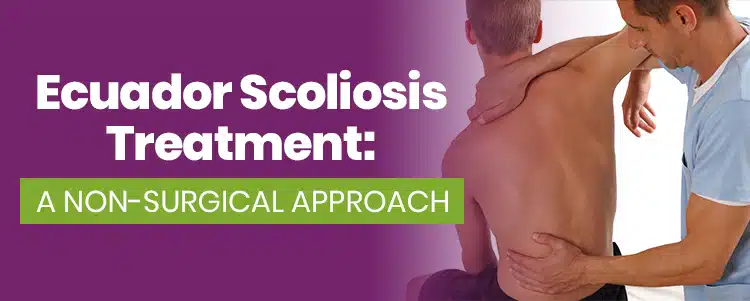Choosing the type of scoliosis treatment approach to commit to has far-reaching effects, making it the most important choice a patient is faced with; this is because as a progressive condition, scoliosis has it in its nature to worsen over time, and in addition, different treatment approaches achieve their goals in different ways and offer patients different potential outcomes.
For residents of Ecuador in search of effective non-surgical scoliosis treatment, Dr. Tony Nalda, of the Scoliosis Reduction Center® in Celebration, Orlando, is approximately 2,100 miles away. While a 6-hour flight is a lengthy journey, it can help put a loved one on the path of treatment success.
A patient’s scoliosis-journey starts with their diagnosis, so let’s start there.
Being Diagnosed with Scoliosis
When a patient is diagnosed with scoliosis, it can be a confusing time filled with uncertainty.
Many patients wonder how bad their condition will get and how it will affect them, and others wonder if their diagnosis will limit their potential or interfere with life goals.
The reality is that we have learned so much about scoliosis, and treatment efficacy, over the years, that we now know patients can not only survive with scoliosis, but thrive with it; this is the case with many famous people and celebrities who became known for their talent, while most are unaware they are living with scoliosis.
Being diagnosed with scoliosis means an unnatural sideways spinal curvature has developed, and the unnatural spinal curve doesn’t just bend unnaturally to the side, but also twists, and this rotational component makes scoliosis a complex 3-dimensional spinal condition.
In addition, a scoliotic curve has to be of a minimum size to be considered a true scoliosis: a minimum Cobb angle measurement of at least 10 degrees.
A patient’s Cobb angle is determined during X-ray and tells me how far out of alignment a scoliotic spine is, and classifies conditions based on severity:
- Mild scoliosis: Cobb angle measurement of between 10 and 25 degrees
- Moderate scoliosis: Cobb angle measurement of between 25 and 40 degrees
- Severe scoliosis: Cobb angle measurement of 40+ degrees
- Very-severe scoliosis: Cobb angle measurement of 80+ degrees
Condition severity is a key condition characteristic that treatment plans are shaped around, along with patient age, condition type (cause), and curvature location.
So now that we’ve defined the condition, let’s address the different treatment options: surgical versus non-surgical.
Scoliosis Treatment Options
As a progressive and incurable condition, once a diagnosis of scoliosis is given, it’s going to be a part of that person’s life, so how it’s treated can have far-reaching effects.
As a progressive condition that’s virtually guaranteed to get worse at some point, I don’t want to waste valuable treatment time, which is why I start treatment as close to the time of diagnosis as possible.

Here in Celebration, Orlando, Florida, I started my non-surgical scoliosis treatment center over 20 years ago, and now, people are traveling from all over the world to access the type of non-surgical treatment available.
People from as far away as Ecuador traverse over 2,000 miles, and take a 6-hour flight, to be within reach of an effective conservative scoliosis treatment method with proven results.
The reality is that treatment isn’t always as accessible to people from different parts of the world, so in particular, for residents of countries without limitless access to effective non-surgical scoliosis treatment, like Ecuador, some have to travel farther.
There are two main scoliosis treatment approaches for patients to choose between, and as I obviously favor a non-surgical scoliosis treatment response, let’s start there.
Conservative Chiropractic-Centered Scoliosis Treatment
Here at the Center, there are a number of benefits that bring patients in to see me from far and wide.
First of all, as I apply an integrative approach that combines multiple condition- specific treatment disciplines into proactive treatment plans, patients have access to different types of treatment under one roof, so while they might have to travel to access the Center, once they are here, they experience a wide range of benefits.
In addition, those traveling a long distance to the Center can also enjoy what the state has to offer: Disney World, Universal Studios, beautiful beaches, and Seaworld; thanks to our beautiful location, many choose to make the trip a combined medical/sight-seeing trip.
So whether you are looking for Guayaquil scoliosis treatment, Quito scoliosis treatment, or Cuenca non-surgical scoliosis treatment, there is support and guidance available.
Conservative chiropractic-centered treatment offers patients a different potential treatment outcome than surgical treatment because the spine is affected differently.
Spinal fusion can cost the spine in terms of its overall health, strength, and function, and even when spinal fusion has been successful at straightening a bent spine and stopping progression, many patients are disappointed in their loss of spinal flexibility and range of motion.
Conservative treatment wants to actually correct a scoliosis, and this is worked towards through achieving a curvature reduction, increasing core strength, pushing the spine into a corrective position, and further stabilizing and healing the spine.

Through condition-specific chiropractic care, I work towards actually reducing the scoliotic curve on a structural level, and this involves a series of chiropractic techniques and manual adjustments that can realign the spine.
Increasing core strength can help by making the muscles that support the spine more flexible and strong so they can optimally support the spine, taking pressure off its individual parts and surroundings.
Corrective bracing can improve the spine’s position so augments corrective treatment results, and rehabilitation is the final and ongoing phase of treatment so the spine is further stabilized and healed for long-term sustainable treatment results.
The big difference is in how surgical versus non-surgical scoliosis treatment affects the spine’s long-term health and function; a spine that’s fused is always fused and is going to be more vulnerable to injury, and is also likely to be less functional, than a spine that’s achieved corrective results through conservative treatment.
Conclusion
For residents of Ecuador, Dr. Nalda’s Scoliosis Reduction Center® is a 6-hour flight away, and don’t forget the many other attractions that the Sunshine state has to offer.
World-renowned non-surgical scoliosis treatment could be within a day’s travel time, and that puts loved ones within reach of the type of potential condition improvement that could impact every-day life.
Regardless of where you are located, with progressive conditions like scoliosis, the best time to start treatment is always now so don’t hesitate to reach out for guidance and support.




